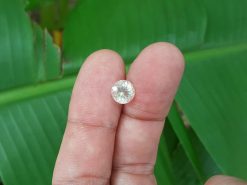Orthoclase

Orthoclase feldspar (endmember formula KAlSi3O8), is an important tectosilicate mineral which forms igneous rock.
Buy natural orthoclase in our gem shop
The name is from the Ancient Greek for “straight fracture,” because its two cleavage planes are at right angles to each other. It is a type of potassium feldspar, also known as K-feldspar. The gem known as moonstone is largely composed of the stone.
Orthoclase feldspar formation
A common constituent of most granites and also other felsic igneous rocks. It is often forms huge crystals and masses in pegmatite.
Similarly, the pure potassium endmember of orthoclase forms a solid solution with albite. The sodium endmember (NaAlSi3O8), of plagioclase. While slowly cooling within the earth. Sodium-rich albite lamellae form by exsolution. It is enriching the remaining with potassium. The resulting intergrowth of the two feldspars is called perthite.
Orthoclase sanidine
The higher-temperature polymorph of KAlSi3O8 is sanidine. Sanidine is common in rapidly cooled volcanic rocks. Such as obsidian and also felsic pyroclastic rocks. We notably found it in trachytes of the Drachenfels, Germany. The lower-temperature polymorph of KAlSi3O8 is microcline.
Adularia is a low temperature form of either microcline or orthoclase originally reported from the low temperature hydrothermal deposits in the Adula Alps of Switzerland. It was first described by Ermenegildo Pini in 1781. The optical effect of adularescence in moonstone is typically due to adularia.
We found the largest documented single crystal in the Ural mountains in Russia. It measured ~10×10×0.4 m and weighed ~100 tons.
Together with the other potassium feldspars, The crystal is a common raw material for the manufacture of some glasses and some ceramics such as porcelain. And finally, as a constituent of scouring powder.
Orthoclase moonstone
Some intergrowths of orthoclase and also albite have an attractive pale luster. It s moonstone. Most moonstones are translucent and white, although grey and peach-colored varieties also occur. In gemology, we call their blue sheen phenomena as adularescence. It is a creamy or silvery white with a billow quality. It is the gem of the state of Florida, USA.
The rainbow moonstone is more properly a colorless form of labradorite. We can distinguish from “true” moonstone by its greater transparency and play of color. Although their value and durability don’t greatly differ.
One of the ten defining minerals of the Mohs scale of mineral hardness, on which it is listed as having a hardness of 6.
NASA’s Curiosity Rover discovery of high levels of stone in Martian sandstones. Some Martian rocks may have complex geological processing. Such as repeated melting.
Orthoclase from Madagascar
Natural orthoclase for sale in our gem shop
We make custom made green orthoclase jewelry as engagement rings, necklaces, stud earrings, bracelets, pendants… Please contact us for a quote.














